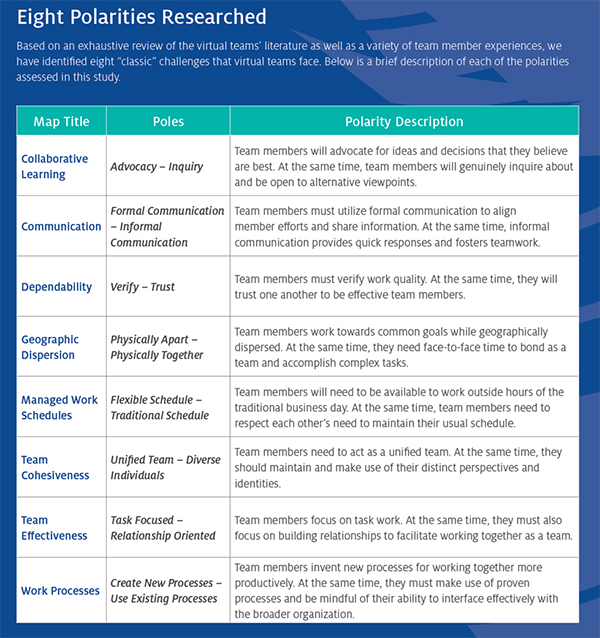As awareness of polarities increases, so does the awareness of multarities. The question about multiple poles comes up frequently in our PACT (Polarity Approach for Continuity and Transformation) Foundations and Professional Applications Certification training. Often, it’s from people who have deep subject matter expertise in a particular area. When they learn about polarities seeing the multiple polarities at play in their industry or body of work happens almost instantaneously.
A Few Examples of Multarities.
Kolb’s Experiential Cycle – two polarities that form this multarity are: Concrete Experience and Abstract Conceptualization; and Reflective Observation and Active Experimentation. The cycle follows the process: 1) Concrete Experience, 2) Reflective Observation, 3) Abstract Conceptualization, and 4) Active Experimentation.
The Myers-Briggs Type Indicator — four polarities that form a multarity related to personality theory: Extraversion and Introversion; Sensing and Intuition, Thinking and Feeling; and Judging and Perceiving.
Practitioners of “Well-Being” frequently identify a high level multarity in the interdependency among: Body, Mind, Emotion, and Spirit. George Mason’s Center for the Advancement of Well-Being (a new strategic partner as of 2019!) is looking at a deeper level into the multarity of Well-Being and the potential for research using the Polarity Assessment.
Dr. Bill Benet developed the Polarities of Democracy multarity — 10 elements laid out in five polarities that are critical for creating healthy, sustainable, and just organizations and communities. They are: Freedom and Authority; Justice and Due Process; Diversity and Equality; Human Rights and Communal Obligations; and Participation and Representation. For more on that you can explore www.InstituteforPOD.org/.
My close friend and colleague, Jake Jacobs developed a multarity for a body of work known as “Real-time Strategic Change,” which consists of six polarities:
Thinking and Acting in Real Time:
For the Greater Purpose Statement (GPS) of Fast Results, you need to both see “The Future Is Tomorrow, Plan for It Today” and see, “The Future is Today, Be in it Now.”
Building Understanding:
To Continue to Learn and Develop (GPS), seek BOTH “Inquiring About What Others Believe” AND “Advocating for What You Believe.”
Making Reality a Key Driver:
For Informed Decisions and Strategic Actions (GPS), you need to know BOTH “Inside of Your Organization” AND “Outside of Your Organization.”
Engaging and Including:
For Smart Choices and More Commitment (GPS), you need to both “Provide Direction” AND “Invite Participation.”
Preferred Futuring:
To energize enthusiasm for Your Best Future (GPS), you need to BOTH “Combine the Best from the Past / Present” AND “Envision Compelling Future Possibilities.”
Creating Community:
For Achieving Peak Performance (GPS), you need to support BOTH “Organization Achieving its Full Potential” AND “Individuals Achieving Their Full Potential.
Peter Koestenbaum’s leadership diamond is a multarity with 4 poles: Vision, Courage, Reality and Ethics. Again, the assertion here is that none of the 4 is sustainable without the other 3. They comprise 4 interdependent components that need each other over time for the Leadership Diamond to support effective leadership.
Ken Wilber’s Integral Theory. (See Cliff’s Note on that!)
High-level Polarity Elements: Individual AND Collective; and, Interior AND Exterior
Focused Application Elements:
Personal Meaning AND Individual Behavior
Personal Meaning AND Culture/Shared Values
Personal Meaning AND Systems/Processes
Individual Behavior AND Culture/Share Values
Individual Behavior AND Systems/Processes
Culture/Shared Values AND Systems/Processes

In 2017 one of our strategic partners, the Center for Creative Leadership, conducted a research study of high-performing virtual teams. Based on an exhaustive review of the virtual teams literature and their own experiences, they identified eight “classic” challenges that virtual teams face. On the right is a brief description of each of the polarities that comprise this multarity.
This research showed that the team’s ability to leverage polarities positively relates to team effectiveness indicators including team performance as well as individual team members’ satisfaction, trust, commitment, professional development, learning, sustainability/viability (intent to remain). Additionally, the research suggested that organizations should provide increased education about polarity thinking, coupled with increased emphasis on information sharing between team members. (This is particularly important to the extent to which team members are spread out across time zones and use more asynchronous virtual tools such as to email and online collaborative websites to coordinate and execute team processes.)
So, there’s already some great work out there on multarities, even if they’re not being referred to as such! As polarity theory continues to advance, there will be increasing focus in the academic research and attention placed on “multarities.”







